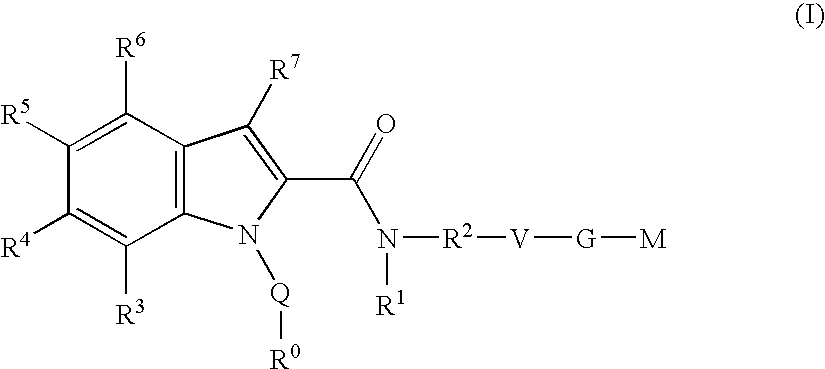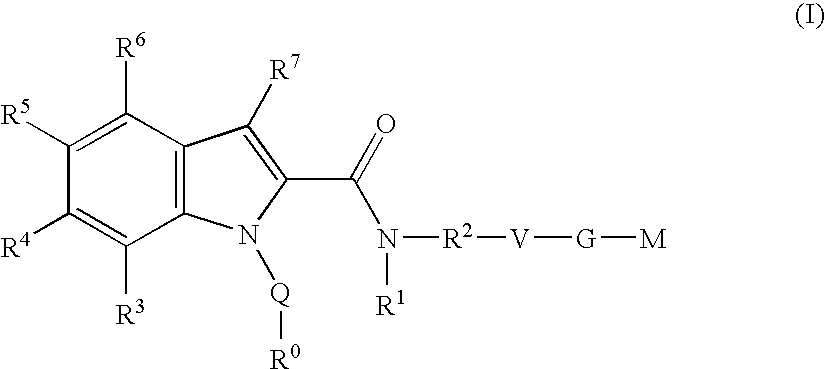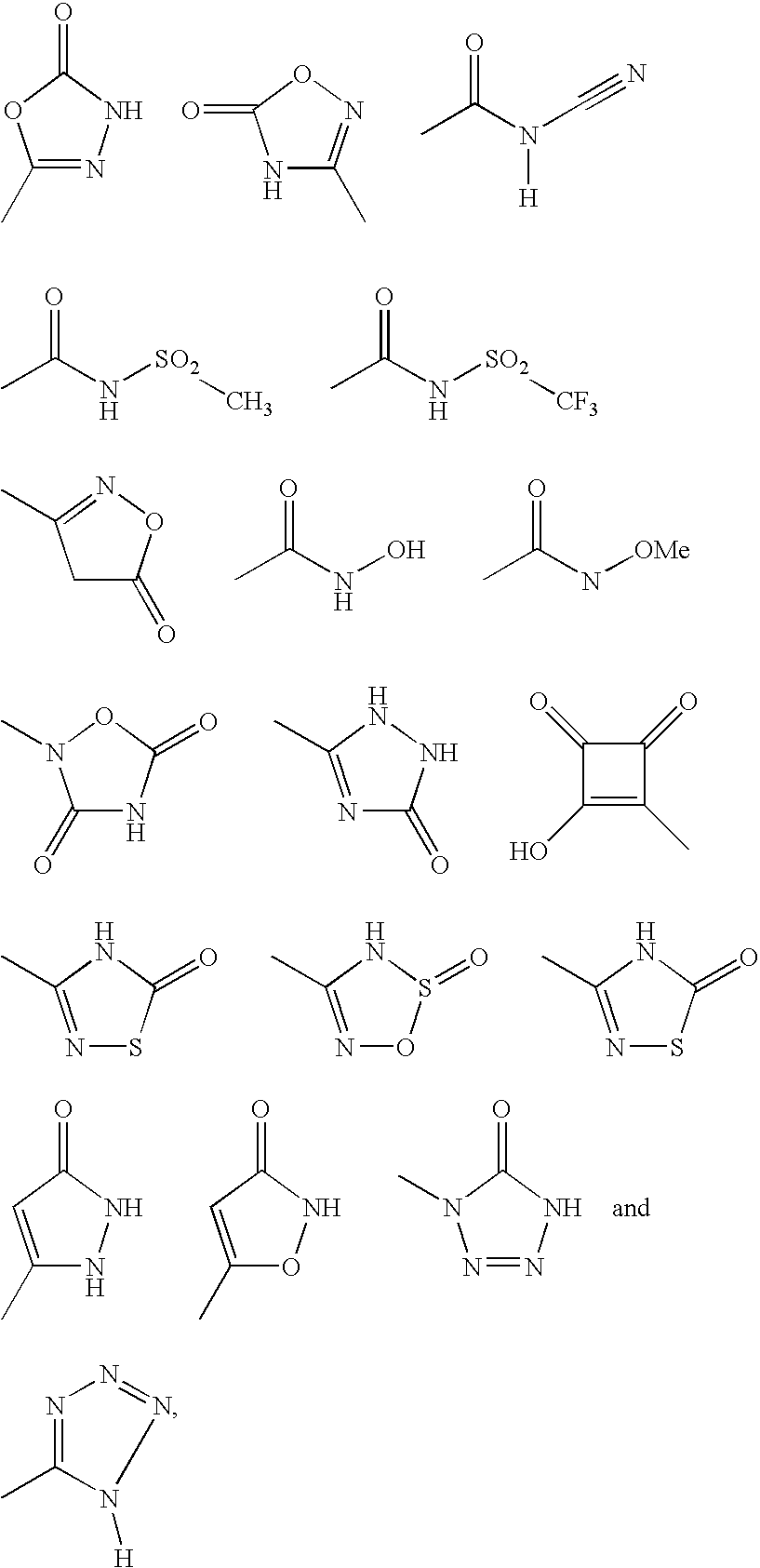Indole derivatives as factor Xa inhibitors
a technology of factor xa inhibitor and indole derivative, which is applied in the field of compounds, can solve the problems of unstable angina, acute myocardial infarction, and unsatisfactory property profile of these compounds
- Summary
- Abstract
- Description
- Claims
- Application Information
AI Technical Summary
Problems solved by technology
Method used
Image
Examples
example 1
1-[5-(5-Chloro-thiophen-2-yl)-isoxazol-3-ylmethyl]-5-(3-hydroxy-azetidine-1-carbonyl)-1H-indole-2-carboxylic acid (1-isopropyl-piperidin-4-yl)-amide
(i) 1H-Indole-2,5-dicarboxylic acid 2-ethyl ester 5-isopropyl ester
To a solution of 31 g AlCl3 in 400 ml DCM, 20 ml oxalyl dichloride was added dropwise. Then, after 30 min 20 g 1H-Indole-2-carboxylic acid ethyl ester in 200 ml DCM were added and the reaction mixture was stirred for 2 h. The reaction mixture was poured on to crushed ice and extracted twice with 500 ml DCM. The organic layer was dried over MgSO4 and the solvent removed under reduced pressure. The residue was taken-up in 500 ml Propan-2-ol and stirred for 4 h at room temperature. After concentration of the reaction mixture under reduced pressure the residue was purified by chromatography on silica gel eluting with an ethyl acetatelheptane 1:10->4:1 gradient. Yield: 5.24 g.
(ii) 1-[5-(5-Chloro-thiophen-2-yl)-isoxazol-3-ylmethyl]-1H-indole-2,5-dicarboxylic acid 2-ester 5-...
example 1a
1-[5-(5-Chloro-thiophen-2-yl)-isoxazol-3-ylmethyl]-2-(1-isopropyl-piperidin-4-ylcarbamoyl)-1H-indole-5-carboxylic acid
Alternatively 1-[5-(5-Chloro-thiophen-2-yl)-isoxazol-3-ylmethyl]-2-(1-isopropyl-piperidin-4-ylcarbamoyl)-1H-indole-5-carboxylic acid can be prepared by the following procedure (a)-(f):
(a) 1H-Indole-2,5-dicarboxylic acid 5-methyl ester
A solution of 25 g 4-Amino-3-Iodo-benzoic acid methyl ester, 19 ml 2-Oxo-propionic acid, 30.4 g 1,4-Diaza-bicyclo[2.2.2]octane and 1 g Pd(OAc)2 in 200 ml DMF was heated under argon to 100° C. After 5 h the reaction mixture was concentrated under reduced pressure and the residue was partitioned between 300 ml ethyl acetate and 200 ml 1 M hydrochloric acid. The organic layer was dried over MgSO4 and the solvent removed under reduced pressure to yield a yellow solid (6.4 g). From the aqueous layer additional product slowly precipitated as a white solid (7.9 g) which was collected by filtration. Both fractions were combined, dried in va...
example 2
1-[5-(5-Chloro-thiophen-2-yl)-isoxazol-3-ylmethyl]-5-(2-hydroxymethyl-pyrrolidine-1-carbonyl)-1H-indole-2-carboxylic acid (1-isopropyl-piperidin-4-yl)-amide
To 50 mg 1-[5-(5-Chloro-thiophen-2-yl)-isoxazol-3-ylmethyl]-2-(1-isopropyl-piperidin-4-ylcarbamoyl)-1H-indole-5-carboxylic acid in 1 ml DCM and 0.3 ml NEt3, 11 mg Pyrrolidin-2-yl-methanol and 24 mg BOP-Cl were added at RT and the mixture was stirred for 16 h. After removal of the solvent under reduced pressure the residue was directly purified by preparative HPLC (C 18 reverse phase column, elution with a H2O / MeCN gradient with 0.1% TFA). The fractions containing the product were evaporated and lyophilized to yield a white solid. The product was obtained as its trifluoroacetate salt. Yield: 41 mg. MS (ES+): m / e=610, chloro pattern.
PUM
 Login to View More
Login to View More Abstract
Description
Claims
Application Information
 Login to View More
Login to View More - R&D
- Intellectual Property
- Life Sciences
- Materials
- Tech Scout
- Unparalleled Data Quality
- Higher Quality Content
- 60% Fewer Hallucinations
Browse by: Latest US Patents, China's latest patents, Technical Efficacy Thesaurus, Application Domain, Technology Topic, Popular Technical Reports.
© 2025 PatSnap. All rights reserved.Legal|Privacy policy|Modern Slavery Act Transparency Statement|Sitemap|About US| Contact US: help@patsnap.com



